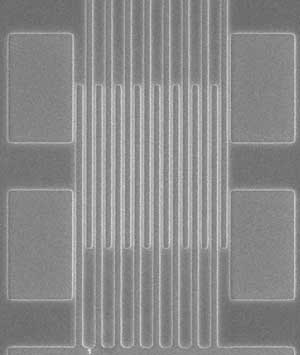Superconducting nanowire devices incorporate optical cavity.
Hank Hogan
Researchers at MIT in Cambridge, Mass., at its Lincoln Laboratory in Lexington, Mass., and at Moscow State Pedagogical University have improved the detection efficiency of superconducting nanowire single-photon detectors at 1550 nm from 17 percent to 57 percent. The advance could have applications in ultralong-range optical communications, quantum cryptography and integrated circuit testing.
Such applications require single-photon detectors with high efficiencies, high counting rates, low dark count rates, and little jitter or unwanted signal timing variation. Until now, superconducting nanowire single-photon detectors had displayed all of those characteristics except high efficiency.

To increase the detection efficiency of the superconducting NbN nanowire single-photon detector, the researchers added an antireflection coating and an integrated optical cavity of hydrogen silsesquioxane.
The scientists have addressed that by adding an antireflection coating and an integrated optical cavity to their device. The latter was particularly important, said Karl K. Berggren, research team leader and an assistant professor of electrical engineering at MIT.
To produce the detector, they fabricated NbN nanowires on a sapphire substrate using electron-beam lithography and the spin-on-glass hydrogen silsesquioxane (HSQ). The result was a 3 × 3-µm area traversed by 100-nm-wide wires spaced 100 nm apart. Atop the wires, they constructed the integrated optical cavity of HSQ, which was capped with a Ti/Au mirror. They chose the thickness of the cavity — 195 nm — to optimize performance. In a final efficiency improvement, they added an antireflection coating of 277-nm-thick HSQ on the side of the sapphire opposite the nanowires, cavity and mirror.
In operation, infrared radiation passes through the coating, which boosts the efficiency by a few percent, and the sapphire before striking the nanowires. Photons making it by the nanowires in the first pass are reflected by the mirror back into the device, where they are trapped by the optical cavity, increasing the chances of later absorption.
Berggren noted that they used the spin-on glass for the cavity material because it is convenient and because it avoids the potential for damage to the device that another dielectric deposition method might cause.
The researchers tested several hundred detectors during various stages of the manufacturing process. They found that the efficiency increased with the addition of both the cavity and coating. The maximum photon-counting rate for the devices was 300 MHz.
Berggren said that future research will attempt to enable them to better understand how the detectors work. Other goals include achieving higher data rates, making arrays of the devices and operating them at higher temperatures. A near-term objective is to figure out how to package them, because their small size makes getting the radiation onto a detector a challenge.
“We need to improve our package so that light from a fiber can be aligned and focused onto the detector without losing so much of it,” Berggren said. He predicted that this should be possible within a few years.